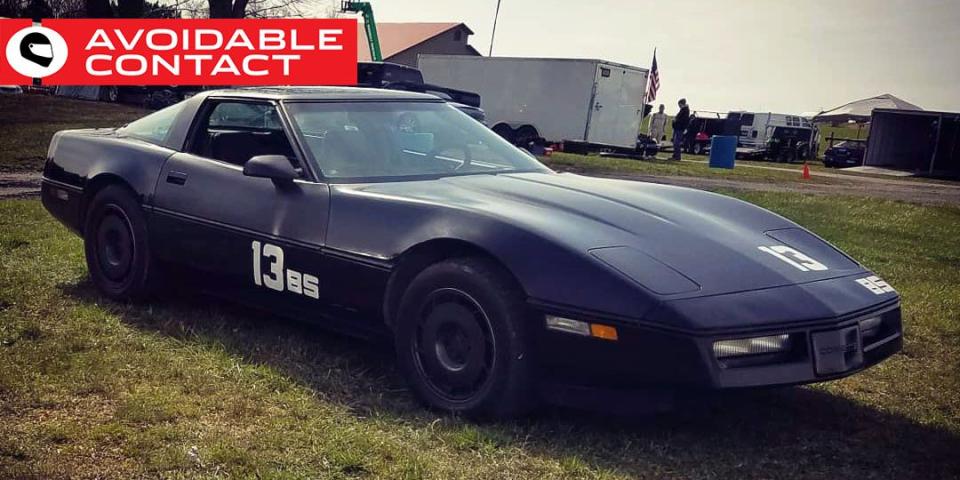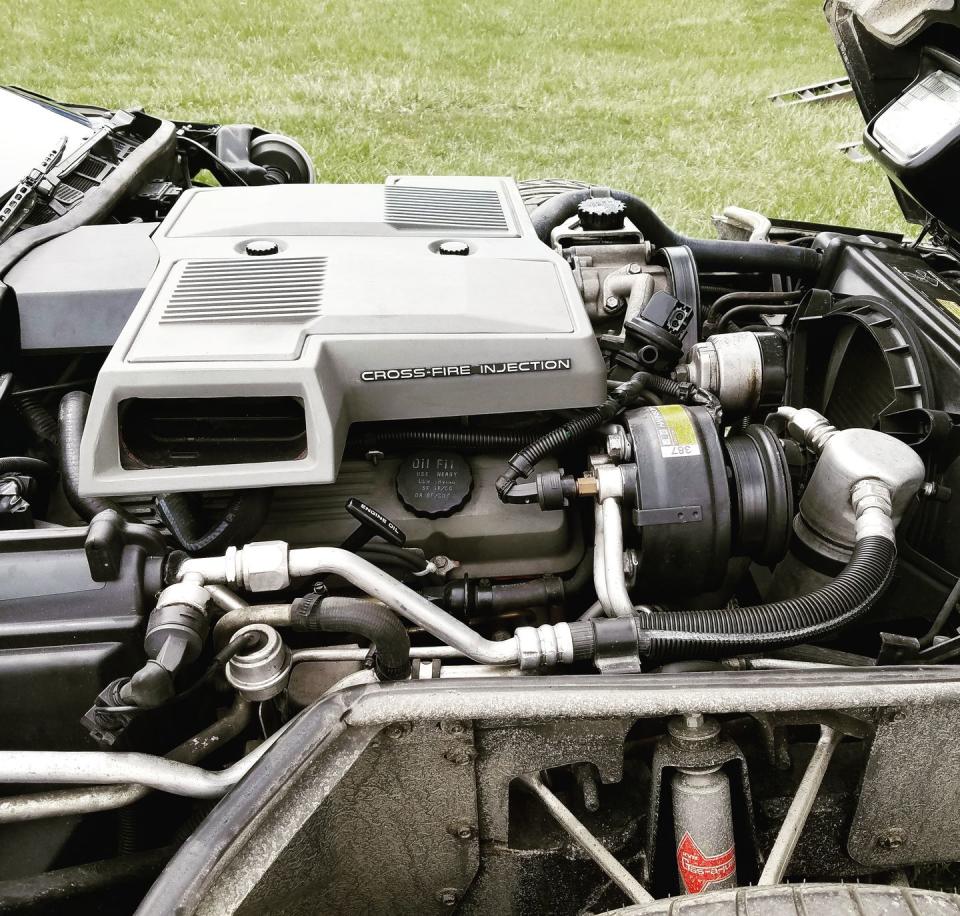This Corvette Finally Made It to a Racetrack

If you’re looking for a solid illustration as to why the so-called “Malaise Era” was so unpleasant for sports-car enthusiasts, here’s a good example: The all-new 1984 Corvette showed up with a nightmarishly unreliable digital dashboard, Trabant-level fit and finish, not one but two laughably bad transmissions, and a “fuel-injection” system that was basically a toilet-bowl carburetor with two trouble-prone injectors. It made 205 horsepower on a good day and it weighed about the same as a 470-horsepower 2018 Stingray. The optional suspension system was sprung harshly enough to send random trim pieces flying every time the car hit a bump. And we were thrilled to have it.
In truth, the C4 Corvette was a remarkable piece of engineering that improved on an annual basis all the way to the sublime LT4-powered Grand Sport and Collector’s Edition in 1996. But even the early cars were developed and engineered with a competitor’s mindset. Compared to its heavy, claustrophobic, boulevard-focused 1982-model-year predecessor, the C4 was basically a race car.
If you see a round-taillight, recessed-foglight C4 on the street nowadays, it’s usually from the later years of the model run. The 1989-1991 models with the L98 engine and six-speed manual made a name for themselves in SCCA Solo and they were put together a bit better than the early cars. In fact, until a few weekends ago I hadn’t seen a genuine ‘84 Corvette in years.
You can imagine my surprise when my friend Josh showed up for my NASA race at Mid-Ohio with an early-production 1984 C4 Z51. Josh, who is the fueler for my endurance race team and impromptu crew chief for my sprint races, bought the car on a whim last year and set about putting it into working condition. I wouldn’t call it a “barn find,” but it arrived with some interesting history. To begin with, the original owner had some wacky ideas about specification. He ordered it with the “gymkhana” Z51 suspension option that was famous for rattling teeth–but he also ordered it with the automatic transmission instead of the “4+3” overdrive-equipped Doug Nash manual. He checked off almost every option in the book, but he insisted on cloth seats, which still look brand-new more than three decades later.

Most importantly, he hadn’t driven it very much, averaging just over 1300 miles a year. The paint faded over time and most of the rubber in the car needed some attention, but the original “Cross-Fire” toilet-bowl injection system (often called “Cease-Fire” for its tendency to strand the car) was present and accounted for when Josh took delivery. Changing to a fuel pump from the 1985 Tuned-Port ‘Vette fixed most of the idling and acceleration issues.
A local autocross at the beginning of April showed Josh that he’d managed to bring the car more or less up to snuff, enough for him to trust it on the 450-mile round-trip from his home in Detroit to my race at Mid-O. Once I saw the car, however, I thought we could perhaps trust it just a little bit further.
I’ve written about NASA’s Hyperdrive program before, but this year the Great Lakes Region has made the program even more interesting. For $99 you get two on-track sessions, some classroom instruction, a year’s NASA membership, and a $50 gift certificate for future NASA events. I thought the faded-black C4 would be an ideal candidate for Hyperdrive, so I sent Josh to the registrar’s table first thing Saturday morning.

A few hours later, I found myself sitting on the grass outside Mid-Ohio’s Turn Six watching Josh find his way around the track, the old iron-block Chevy engine burbling through an H-pipe and Magnaflow dual exhausts like a Sixties musclecar. There was something hilarious about seeing how little body roll the Z51 package permitted when compared to the Porsches, BMWs, and even the modern Corvettes that were also in the Hyperdrive group. It’s easy to tell just how seriously Chevrolet took Showroom Stock racing back in the Eighties. The C4 has the flat stance and aggressive demeanor you’d normally associate with completely-prepped vehicles.
Josh alternated between shifting himself and letting the transmission make its own choices. Neither strategy produced much acceleration; an automatic Cross-Fire Corvette would find itself trailing a Toyota Sienna by ten or fifteen lengths in a quarter-mile drag, and the power peak occurs well before the 5,000-rpm mark on the digital tach. Yet his overall pace was pretty good and he wound up passing a few cars in the second session.
“I didn’t use the brakes much,” he reported afterwards. “They faded almost immediately. I blame the semi-metallic pads, which were like fifty bucks.” It’s possible to bleed the brakes on an early C4 by lifting the massive hood and putting the bleeder hose onto the caliper from behind the wheel. Too bad you can’t do the same thing with the modern Vettes!
Josh finished his sessions absolutely thrilled with his car’s reliability and performance. I dare say he would not have had a similar experience had he bought, say, a 1980 C3 Corvette. It’s easy to forget just how much the ‘84 did to build the marque’s sporting reputation and credibility. By the time the C5 arrived in 1997, the big Chevy had seen off pretty much all the competition, from 300ZX to Supra to Porsche 968. Modern enthusiasts expect that each new generation of Corvette will set new standards for both raw laptime and approachable performance. That’s the legacy started by Josh’s C4.

Later that evening, we fired it up for a trip to dinner. I stepped on over the knee-height frame rails and settled into the deep channel between frame and center console. The dashboard lit up and flickered wildly, speed and tach readings trailing reality by a noticeable interval. Josh hit the headlight switch and the lamps did their little 180-degree flip/rotate into position. Thundering down the main street of my little town at an appropriately sedate pace, it was easy for me to remember how impressed I was by the ‘84 Corvette when it arrived. I was just twelve years old at the time and the C4 seemed like a spaceship compared to everything else on the road.
There’s still something really cool about the unashamed ambition behind the fourth-generation Corvette. It completely redefined the brand and set expectations that are still followed thirty-four years later. The ultimate expression of its racer-for-the-road aesthetic was probably the C6 Z06, which shared a tremendous amount of visual DNA with the 1984 C4 and approached the road with that same unforgiving attitude as its predecessor. Yet even the new C7 ZR1 owes more to Josh’s car than it does to any of the Corvettes that went before.
I’ve written quite a bit in these pages about how a C5 Vette is the ultimate trackday performance bargain, and I stand by those words. If you’re looking for a collector car with some enthusiast potential, however, a pre-LT1 C4 might be just the ticket. Find a good example now and you might just benefit from the bizarre wave of Eighties nostalgia that is being rather cynically manufactured by various entities at the moment. Best of all, it’s still capable of entertaining you in a Hyperdrive (or SCCA Track Night) session. Thirty-four years after it arrived, the C4 is finally getting the respect it deserves. If you ask Josh, or me… it’s about time.
You Might Also Like

 Yahoo Autos
Yahoo Autos 